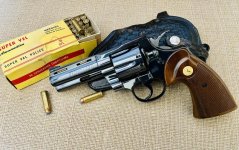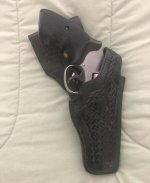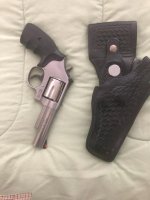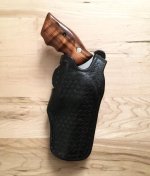- Joined
- Feb 9, 2006
- Messages
- 3,560
- Reaction score
- 6,297
In the 70s I recall Sam Brown with a big brass buckle, a high ride Three Persons style holster with retention strap and double dump pouches. Some of the guys used swivel holsters with or without ammo loops. I couldn't get comfortable with them. I used speed strips in the dump pouches
and the chief (who carried a M39) looked the other way. Small department. As long as it was black basketweave and shined you were good.
In the 80s (much larger department) we used all Safariland leather: a velcro Sam Brown, the 229 holster, a Jordan/Border Patrol style with a thumb break, or its high rise counterpart, double speed loader pouch and flap cuff case. A second cuff case was authorized (and a darn fine idea). All black basketweave. Rings for Kel-lite and night stick, Mace holster (just for show). Velcro belt keepers and a velcro underbelt. That was department mandated private purchase. Key clips were authorized but seldom worn. No knives, grappling hooks or boomerangs on the duty belt.
and the chief (who carried a M39) looked the other way. Small department. As long as it was black basketweave and shined you were good.
In the 80s (much larger department) we used all Safariland leather: a velcro Sam Brown, the 229 holster, a Jordan/Border Patrol style with a thumb break, or its high rise counterpart, double speed loader pouch and flap cuff case. A second cuff case was authorized (and a darn fine idea). All black basketweave. Rings for Kel-lite and night stick, Mace holster (just for show). Velcro belt keepers and a velcro underbelt. That was department mandated private purchase. Key clips were authorized but seldom worn. No knives, grappling hooks or boomerangs on the duty belt.
Last edited:








